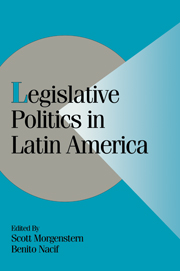Book contents
- Frontmatter
- Contents
- Tables and Figures
- Contributors
- Preface and Acknowledgments
- Party Names and Other Acronyms and Abbreviations
- 1 TOWARDS A MODEL OF LATIN AMERICAN LEGISLATURES
- Part I Executive–Legislative Relations
- Part II Political Parties and Legislative Structure
- 6 EXPLAINING THE HIGH LEVEL OF PARTY DISCIPLINE IN THE ARGENTINE CONGRESS
- 7 PARTY DISCIPLINE IN THE CHAMBER OF DEPUTIES
- 8 PARTIES, COALITIONS, AND THE CHILEAN CONGRESS IN THE 1990s
- 9 UNDERSTANDING PARTY DISCIPLINE IN THE MEXICAN CHAMBER OF DEPUTIES: THE CENTRALIZED PARTY MODEL
- Part III Legislatures and the Policy Process
- Part IV Conclusions
- References
- Author Index
- General Index
7 - PARTY DISCIPLINE IN THE CHAMBER OF DEPUTIES
Published online by Cambridge University Press: 14 January 2010
- Frontmatter
- Contents
- Tables and Figures
- Contributors
- Preface and Acknowledgments
- Party Names and Other Acronyms and Abbreviations
- 1 TOWARDS A MODEL OF LATIN AMERICAN LEGISLATURES
- Part I Executive–Legislative Relations
- Part II Political Parties and Legislative Structure
- 6 EXPLAINING THE HIGH LEVEL OF PARTY DISCIPLINE IN THE ARGENTINE CONGRESS
- 7 PARTY DISCIPLINE IN THE CHAMBER OF DEPUTIES
- 8 PARTIES, COALITIONS, AND THE CHILEAN CONGRESS IN THE 1990s
- 9 UNDERSTANDING PARTY DISCIPLINE IN THE MEXICAN CHAMBER OF DEPUTIES: THE CENTRALIZED PARTY MODEL
- Part III Legislatures and the Policy Process
- Part IV Conclusions
- References
- Author Index
- General Index
Summary
Although political parties are key actors in all legislatures, their roles vary enormously. In Great Britain and Argentina, parties are the main players, and the legislative game can be understood with few references to individual deputies. No one would argue that Brazil's legislative parties have the strength of Argentina's Peronists or Britain's Labor Party. Nonetheless, leaders of Brazil's congressional parties organize the legislative calendar, participate in legislative negotiations, and mediate between individual deputies and ministers.
This chapter adapts theories of legislative parties to the Brazilian case. The first section demonstrates that Brazilian presidents, while powerful, are far from dominant. From the administration of José Sarney through the first government of Fernando Henrique Cardoso, most executive proposals come out of the legislature highly modified or fail to come out at all. Why do presidential proposals so seldom emerge unscathed from the Congress? Do party leaders, especially leaders of parties that are nominally part of presidential coalitions, really oppose these proposals? If, instead, party leaders are simply unable to marshal their troops to support these bills, why are backbench deputies so reluctant?
The answers lie in the nature of Brazil's legislative parties. The second section reviews the theoretical literature on legislative parties, a literature based mainly on the U.S. experience. This dscussion demonstrates that Brazil ought to be a case of “conditional party government.” Given Brazil's electoral rules and its federal structure, influence should flow from the bottom up, from party members to leaders, not from the top down.
- Type
- Chapter
- Information
- Legislative Politics in Latin America , pp. 185 - 221Publisher: Cambridge University PressPrint publication year: 2002
- 36
- Cited by

